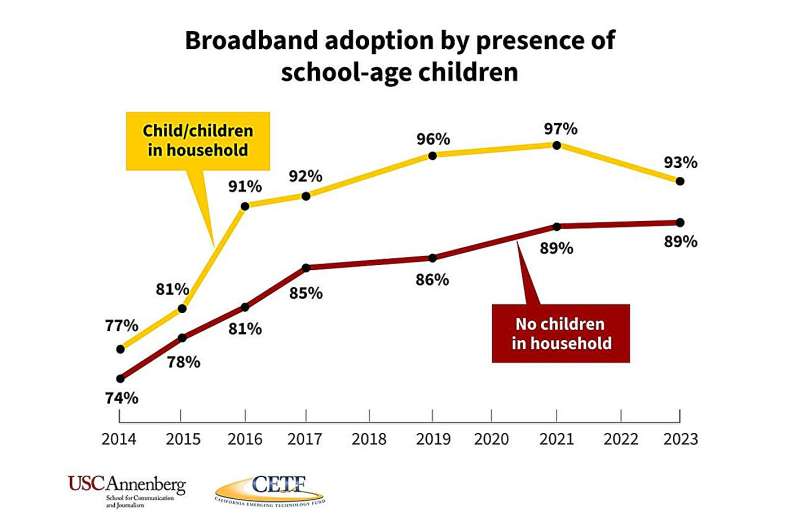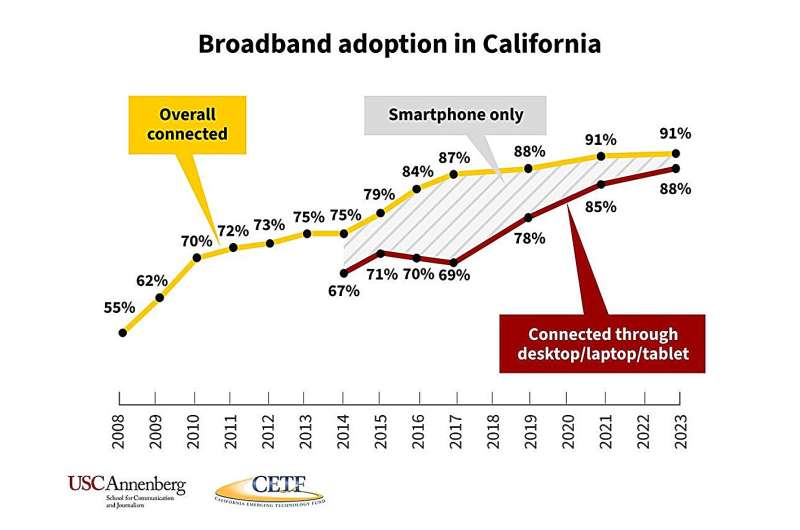This article has been reviewed according to Science X's editorial process and policies. Editors have highlighted the following attributes while ensuring the content's credibility:
fact-checked
trusted source
proofread
Survey shows digital divide narrowing in California, but many low-income residents still under-connected

Statewide broadband adoption remains high with 91% of households in California enjoying high-speed internet access at home, according to new survey results released today by USC, the California Emerging Technology Fund and the California Department of Technology.
The overall findings are consistent with the 2021 results of the biennial Statewide Digital Equity Survey, which monitors Californians' digital access. The latest findings also reveal that the percentage of under-connected households—those with only a smartphone—was cut in half from 6% to 3%.
However, broadband adoption among families with school-age children decreased from 97% in 2021 to 93% in 2023, likely due to the expiration of school-based programs that sponsored internet connectivity during the COVID-19 pandemic.
In addition, fewer children in K-12 households have a desktop, laptop or tablet computer available at home to use for school activities that are not shared with other family members, a decline from nearly 95% in 2021 to about 72% in 2023, the researchers found.
"There was significant progress in reducing the number of under-connected households," said Hernán Galperin, the study's lead researcher and a professor at the USC Annenberg School for Communication and Journalism. "However, our latest data also point to the sobering reality of the challenges in reaching the most digitally disadvantaged households."
The 2023 survey is the largest endeavor to date by USC Annenberg researchers with CETF in collaboration with the California Department of Technology to obtain a highly representative sample of Californians, said Sunne Wright McPeak, president and CEO of CETF.
"We went to great lengths developing a robust methodology to get the clearest picture of how Californians are faring in broadband adoption," said McPeak. "We now know we still have some miles to go for Californians to achieve full adoption. The survey confirms that affordability remains the major barrier to broadband adoption and underscores the need to ensure that low-income households always will have affordable home internet service available to them."

The researchers used a multimodal approach—an effective method for sampling hard-to-reach populations, including unconnected and under-connected households—by combining text-to-online responses with telephone interviews conducted through random digit dialing.
In addition, researchers oversampled residents in rural counties and low-income households, as well as people with disabilities.
More Californians come online
The results show that California has made significant progress in improving internet access among specific disadvantaged groups, such as:
- Households with disabilities, up from 83% in 2021 to 91% in 2023
- Adults 60 years and older, increasing from 78% in 2021 to 90% in 2023
- Adults without a high-school degree, up from 64% in 2021 to 79% in 2023
The data also show that overall adoption trends among racial minority groups improved over the past decade. Among Asian Americans, broadband adoption levels have reached similar levels as those among non-Hispanic white residents. Hispanic/Latino residents still trail non-Hispanic white residents by about 10 percentage points; however, the most recent data show progress in broadband adoption after several years of declines, the researchers wrote.
"To truly eliminate the digital divide, we must confront racial and ethnic disparities by implementing targeted strategies and policies that uplift digitally disadvantaged communities," said François Bar, co-author of the study and professor of communication and spatial sciences at USC Annenberg. "The insights gleaned from this latest survey can help shape these initiatives."



















